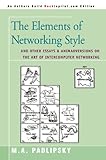Another problem that I read about at the time is that some of the ISO protocols didn't work. The "ISORMites" (http://www.amazon.com/Elements-Networking-Style-Animadversio...) were reported to be contemptuous of the Internet protocols, their origin from the "US Department of Death", etc. ... and didn't have a policy like the IETF's "running code wins" approach.
More generally, per http://www.ietf.org/tao.html "One of the 'founding beliefs' is embodied in an early quote about the IETF from David Clark: 'We reject kings, presidents and voting. We believe in rough consensus and running code'"
I'm not sure the author realizes TCP is a virtual circuit protocol (then again I'm sure OSI had one or more much heavier weight ones).
The real fatal flaw of OSI, before even getting to the point of finding out if their protocols worked---many of them did get far enough in standardization process---was their going to ISO in the first place. If you just needed to get things done, the difference between spending around $2,000 ($1,000 in 1988 dollars) to buy a shelf of the standards documents, or $0 or thereabouts to get all the RFCs (chicken and egg, you might need to buy a CD or a tape to get them to your systems), made a very big difference.
If you're really interested in all this, I highly recommend Padlipsky's very opinionated "The Elements of Networking Style: And Other Essays & Animadversions on the Art of Intercomputer Networking" (http://www.amazon.com/Elements-Networking-Style-Animadversio...), a very colorful work with rhetorical gems like "gilding the ragweed".


Innovations in Internetworking (https://www.amazon.com/Innovations-Internetworking-Artech-Te...) is a great collection of papers that help you understand the original thinking behind each protocol
The Elements of Networking Style (https://www.amazon.com/Elements-Networking-Style-Animadversi...) explains why you see only 4 layers in the real Internet while ISO slices it into 7 and all the fun parts os standard bodies while retaining a unique sense of satire